I found this Interesting presentation by Jan Chipchase on “Pattern Recognitionâ€.
“On the challenges of exploring patterns in human behaviour, culture and technology, and the art of finding opportunities where they collide.”
vivek
I found this Interesting presentation by Jan Chipchase on “Pattern Recognitionâ€.
“On the challenges of exploring patterns in human behaviour, culture and technology, and the art of finding opportunities where they collide.”
vivek
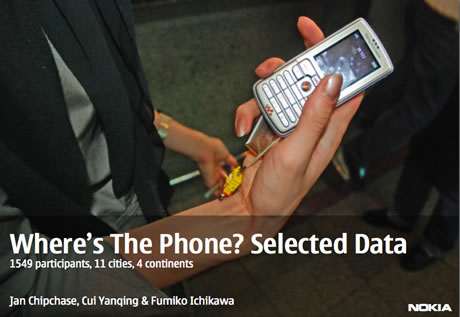
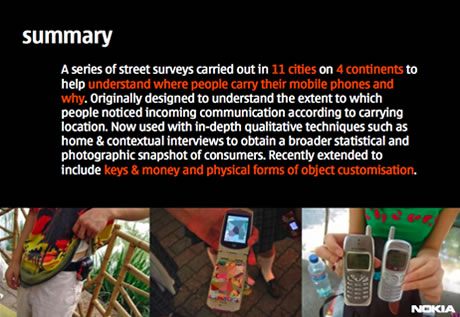
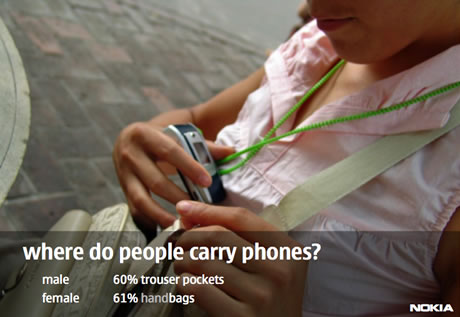
I found this very intresting research paper a Cross Cultural Study on Phone Carrying and Personalisation co-authored by Cui Yanqing and Fumiko Ichikawa which is presented at HCI International 2007 in Beijing.
This essay presents data from a series of Nokia street surveys conducted between 2003 and 2006 that explored where people carry their mobile phones and why?
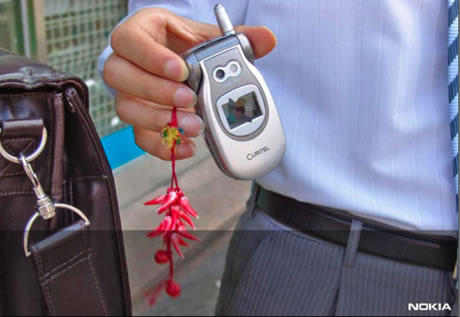
“Where’s the Phone street surveys set out to document the extent to which people noticed their incoming communication and cross refererence this information to the location where the phone is carried. The mobile phone’s effectiveness as a communication device is partly dependent on its owner noticing incoming communication (though whether someone decides to respond to that communication is another matter entirely) and it was assumed by the authors that the process of deciding to carry an object would correlate with a minimal level of its effective use. Contexts where there was a high likelihood of missing incoming communication presented a design opportunity both in terms of thinking about device redesign and from the perspective of connectivity-related services accessed through that device.
Download this pdf here as powerpoint or pdf (3MB).

Read as from Jan Chipchase here.
View results of this research paper here
Very Interesting . .
vivek
A very interesting video via The New York Times of Jan Chipchase own life. He spent a week recording his own nomadic life for us in Tokyo and Seattle, taking pictures and leaving phone messages. It shows how wireless communication is changing the way people work, live, love and relate to places and each other.
Very interesting !
vivek
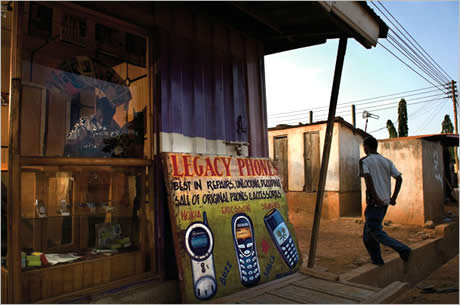
A cellphone shop in Accra, Ghana, which carries and repairs a variety of handsets.
A great article via The New York Times featuring Jan Chipchase and his work style to find about how people use their cell phones, where they keep it, understanding their behaviour in terms of usability, business and Psychology many more ways . . even a simple idea can make a product more innovative and solution providing as mobile phones are getting more personalized mere just not a functional device to talk. The premise of the work is simple – get to know your potential customers as well as possible before you make a product for them.
“This sort of on-the-ground intelligence-gathering is central to what’s known as “human-centered design”, a business-world niche that has become especially important to ultracompetitive high-tech companies trying to figure out how to write software, design laptops or build cellphones that people find useful and unintimidating and will thus spend money on. Several companies, including Intel, Motorola and Microsoft, employ trained anthropologists to study potential customers.”

Chipchase talks to Accra street vendors about what an ideal phone.
Jan Chipchase is 38, a rangy native of Britain whose broad forehead and high-slung brows combine to give him the air of someone who is quick to be amazed, which in his line of work is something of an asset. For the last seven years, he has worked for the Finnish cellphone company Nokia as a “human-behavior researcher.†He’s also sometimes referred to as a “user anthropologist.†To an outsider, the job can seem decidedly oblique. His mission, broadly defined, is to peer into the lives of other people, accumulating as much knowledge as possible about human behavior so that he can feed helpful bits of information back to the company — to the squads of designers and technologists and marketing people who may never have set foot in a Vietnamese barbershop but who would appreciate it greatly if that barber someday were to buy a Nokia.
I really impressed with him, his thoughts to create innovation and more focussed for the people.
vivek
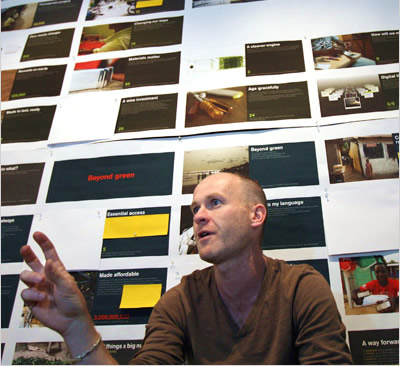
A nice article on The New York Times, what mobile designers think behind the scene and workaround for “hoping to Make Phone Buyers Flip“. Forecasting what consumers will want next year, and into the future. Designing a Mobile phone is just not an easy task there are many things to see, evaluate and analyze around the people. Jotting down feelings about features what users are looking for, share their emotions about mobile phone, understanding the psyche of consumers and why they pick one phone over another.
Even interesting designs do not necessarily spell success. The group is the first of its kind at Nokia, the world’s No. 1 seller of mobile phones, bringing together 14 designers and researchers from California and Helsinki, where the company is headquartered. Their charge is to tell Nokia’s top executives not only what consumers will want next year, but 3 to 15 years from now.
“We have the ability to clarify the needs of real people,†said Rhys Newman, who heads the team.
“Design used to be inconsequential: just make it pretty, make it sell,†said Mr. Newman, who, along with three members of his team, was interviewed at Nokia’s design center near a strip mall in downtown Calabasas, north of Los Angeles. Now, he said, “we have to think about human fundamentals.â€
When asked if they felt pressure to design new phones more quickly in an increasingly competitive market, Mr. Jan Chipchase responded with a quizzical stare. “Why do you want to innovate faster?†he asked. “Are you innovating something gimmicky just to sell a product? Or is it saving the planet you are after?â€
So what you think about your mobile phone, how you use it, Do share your emotions, feelings, and what you want in your phone? 🙂
vivek